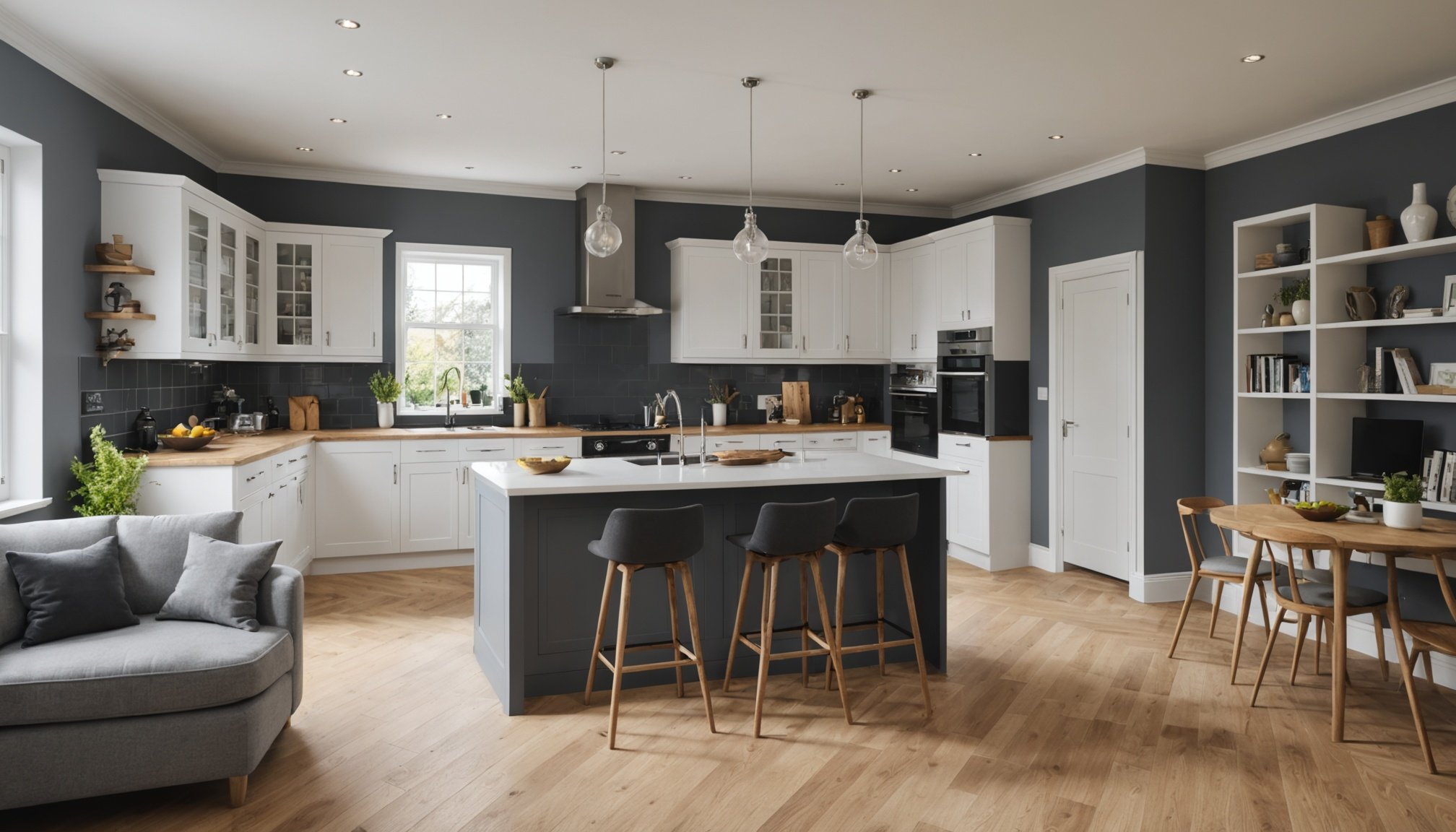Understanding Home Value in the UK
Navigating the UK housing market requires insight into current home value trends. As of late 2023, property values have shown diverse patterns across regions, heavily influenced by specific location and neighbourhood characteristics. Urban areas continue to experience high demand due to their proximity to job markets and amenities, while rural properties offer more value through space and tranquility, attracting different buyer demographics.
Importance of Location
Location is a significant determinant of property value. Proximity to good schools, transportation networks, and local amenities can substantially increase desirability and valuation. Neighbourhood reputation and security also play crucial roles in a property’s home value assessment.
Topic to read : Maximizing gains: a guide for uk property owners to capitalize on the new homes bonus scheme
Key Factors in Appraisal and Demand
Several key factors influence home appraisal and market demand. These include:
- Housing supply and demand dynamics: A limited supply in high-demand areas can elevate prices.
- Interest rates: Affect borrowing capability and buyer willingness.
- Economic conditions: Influence job security and purchasing power.
Understanding these factors helps in navigating UK housing market fluctuations effectively. In particular, keeping an eye on regional developments and governmental policies can offer foresight into potential home value adjustments.
Have you seen this : Unveiling the Evolution of UK Bank Lending Strategies After the Financial Crisis
Budget-Friendly Renovation Ideas
Transforming your home doesn’t have to be expensive, thanks to cost-effective renovations. Projects with a high return on investment (ROI) include freshening up walls with a new coat of paint or updating light fixtures to modern, energy-efficient options. These seemingly small changes can make a substantial impact on your home’s ambiance and home improvement budget.
For those who enjoy a hands-on approach, DIY enhancements offer a rewarding way to rejuvenate spaces while keeping costs low. Simple tasks such as installing shelves or adding new cabinet hardware can enhance functionality and style. However, discerning when to hire professionals is crucial, especially for intricate tasks like electrical work, ensuring safety and compliance with UK regulations.
Energy-efficient upgrades are not only environmentally friendly but can significantly boost a property’s value. Installing double-glazed windows or improving insulation not only cuts energy bills but also appeals to eco-conscious buyers, which is becoming a growing segment in the UK housing market.
By strategically selecting renovation projects, homeowners can enhance their living spaces without straining their finances, proving that impactful home transformations are possible on a limited budget.
Essential Renovation Projects
Refreshing and modernising kitchens and bathrooms are the most impactful essential renovations. Investing in quality fixtures and finishes frequently yields a high return, enticing potential buyers with contemporary aesthetics and functionality. Updated kitchens often serve as the memorable focal point of a home, boosting appeal and capturing attention in competitive markets.
Moreover, enhancing curb appeal is paramount. First impressions matter, and facades with updated landscaping, fresh paint, or new front doors radically improve the perception of value. By investing in exteriors, homeowners can swiftly elevate their property’s attractiveness before prospective buyers even step inside.
It’s crucial to prioritise renovations based on the property type to maximise returns. For example, an outdated kitchen in a luxury home may carry more weight than in a modest property, where minor upgrades might suffice. Assessing which areas require the most attention allows for strategic allocation of resources, ensuring optimal improvement with limited budgets.
Ultimately, thoughtful renovation planning should consider the specific markets and demographics which align with each property type. Owners should align their home improvement projects with analysing what potential buyers in their region desire, creating a customised approach in enhancing home value.
Navigating UK-Specific Regulations
Understanding UK building regulations is essential for successful home renovations. Before embarking on any major project, securing planning permissions is often required. Different types of projects, such as extensions or alterations, have specific permission criteria. Failing to adhere can result in costly legal complications and delays in your home transformation.
A crucial part of UK home renovation laws includes compliance with regulations concerning structural changes, safety standards, and energy efficiency requirements. It’s vital to be aware of building codes, especially those related to electrical and plumbing work, to ensure projects meet current safety standards.
To effectively navigate these regulations, homeowners can utilize various resources. Local planning authorities offer guidance and advice on complying with home renovation laws. Additionally, online platforms provide detailed insights into specific regulations impacting projects in each region. Engaging with these resources helps ensure legal adherence and smooth project completion.
It’s also advisable to consult professionals, such as architects or builders, who are familiar with the intricate details of UK building regulations. Their expertise can prevent potential pitfalls and streamline the renovation process, ensuring that all aspects of compliance are meticulously addressed.
Current Design Trends in Home Renovation
Incorporating the latest design trends can significantly enhance your property’s appeal and boost its value within the UK housing market. Among the myriad of styles, embracing popular home decorating styles such as Scandinavian minimalism or industrial chic can make your space feel both stylish and timeless.
Popular Interior Design Styles
Currently, an emphasis on sustainable materials is reshaping home decorating styles across the UK. Homeowners are increasingly choosing eco-friendly options, such as reclaimed wood and recycled metal, which not only reduce environmental impact but also elevate aesthetic appeal.
Moreover, the concept of an open-plan layout is gaining traction for its ability to create a more inviting and spacious environment. This trend encourages seamless transitions between living areas, fostering a sense of connectivity that’s both modern and functional.
Sustainable Materials and Appeal
The use of sustainable materials aligns with a heightened awareness of environmental responsibility, making properties more attractive to eco-conscious buyers. Investing in renewable resources provides an edge in competitive markets, not just in terms of design but also in adding long-term value to properties.
By staying informed about these design trends, homeowners can make updates that reflect current tastes while ensuring home value appreciates.
Cost Breakdown for Renovation Projects
Embarking on a renovation journey involves understanding renovation costs thoroughly. On average, the expenditure on common projects varies widely across the UK. For instance, updating a standard kitchen can cost between £5,000 and £15,000, while bathroom renovations typically range from £4,000 to £10,000. It’s essential to account for both small-scale and extensive upgrades to estimate effectively.
Creating a realistic budget necessitates meticulous planning. Consider allocating a portion for unexpected expenses to cushion against unforeseen costs. Prioritise projects by distinguishing between essentials and desirable upgrades. Budget estimation should align with the renovation’s scale and homeowner expectations.
Several factors significantly influence the total renovation costs, namely materials, labour, and time. Opting for standard fittings can lower expenses, but investing in quality materials may benefit long-term property value. Labour costs can fluctuate based on the project’s complexity and location within the UK. Time is also a critical determinant; expedited timelines typically increase costs due to the need for additional resources.
By systematically assessing these elements, homeowners can achieve a balanced and efficient renovation strategy, optimising the value and functionality of their living spaces.
Resources and Support for Homeowners
Embarking on a home renovation journey can seem daunting; however, abundant home renovation resources are available to guide UK homeowners. One of the most effective ways to kickstart renovations is by exploring platforms like Houzz and Rated People, which connect you to vetted contractors in the UK capable of bringing your vision to life.
Support networks and online forums, such as the HomeOwners Alliance, offer invaluable community support. These platforms facilitate advice exchange and provide insights into renovation experiences, equipping homeowners with extensive knowledge and recommendations.
Financial aid is crucial for many embarking on renovations. Various government grants and financial assistance programs are designed to alleviate costs associated with home improvements. Schemes like the Green Homes Grant and local authority grants provide opportunities to enhance home efficiency and accessibility, making renovations more affordable.
To truly maximize resources, it’s essential to thoroughly research and engage with trusted professionals. Seeking recommendations from these communities aids in making informed decisions, balancing quality with budget constraints, and navigating each renovation phase successfully. These resources collectively empower homeowners, ensuring efficient and cost-effective project execution.

